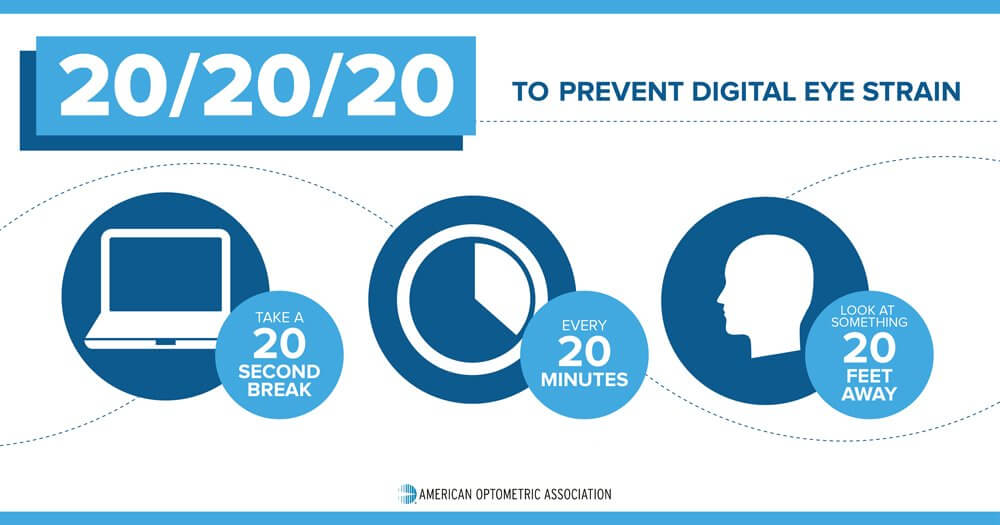Digital Eye Strain
Posted by: Invision Optometry in Category Computer Vision Syndrome

Digital eye strain, also referred to as computer vision syndrome, is the physical discomfort that follows after prolonged computer use. Whether it is your desktop, laptop, tablet, or smartphone, many individuals experience eye discomfort and vision problems when viewing digital screens for an extended period of time. As screen time increases at home or in the office, so do symptoms. From dry eyes and headaches, to shoulder and neck pain as well as blurred vision, the extent to which an individual will experience visual symptoms often depends on their level of visual ability and amount of time spent looking at a digital screen. In fact, uncorrected vision problems like farsightedness, astigmatism, inadequate eye focusing or eye coordination and changes in the eyes due to aging, can all contribute to the development of visual symptoms when using a computer or digital screen.
Make Sure To Tell Your Eye Doctor How Much Time You Spend On A Computer Or Digital Device…
What Causes Digital Eye Strain?
Computer eye strain and computer vision syndrome develop because our eyes and brain react differently to characters on a computer screen than they do to printed characters. Printed material is easier to focus on because it has dense black characters with well defined edges. On the other hand, we have a hard time focusing on the characters on a computer screen because they don’t have the same degree of contrast and definition. Thus, our eyes have to work harder when viewing a digital screen than they do with print. Similar to carpal tunnel syndrome, which is the result of repetitive motion, digital eye strain can get worse the longer you use digital devices. When you work at a computer all day, your eyes have to focus and refocus, as they move back and forth while you read. And, unlike a piece of paper, the screen adds contrast, flicker, and glare. All of this requires a lot of effort from your eye muscles and leads to digital eye strain.
Computer Users Should Have An Eye Exam At Least Once A Year…
Digital Eye Strain And Your Eye Muscles
Imagine flexing your biceps for 10 hours a day for a full week. With that much stress placed on your biceps, the muscles will eventually get tired and not work as well as they could. Now, add years to that same concept, keeping in mind that the eye muscles are not big muscles like biceps. They are a thin, fragile element of one of the most important sensory input mechanisms your brain uses to navigate the world. When you focus on something within a foot or two away, like your computer, your eye muscles are working to focus light precisely to maintain clear vision.And, just as the muscles in your body get tired, your eye muscles get tired too.
During Your Eye Exam Tell Your Eye Doctor How Often You Use A Computer…
What Are The Symptoms Of Digital Eye Strain?
Symptoms of digital eye strain can be caused by poor lighting, glare on a digital screen, improper viewing distances, poor seating posture, uncorrected vision problems or a combination of these factors. If you have computer vision syndrome, also known as digital eye strain, you may experience:
- Red or irritated eyes
- Headaches
- Dry or watery eyes
- Burning eyes
- Blurred or double vision
- Tired eyes
- Back, neck, and shoulder pain
- Physical or mental fatigue
- Loss of focus
- Eye twitching
Having An Annual Comprehensive Eye Exam Is the Most Important Thing You Can Do…

Easing Digital Eye Strain
As technology continues to be a huge part of your daily life, it is important to think about how you can reduce and even prevent the symptoms of digital eye strain. Here are a few steps you can take to make it better. The first step is to get a comprehensive eye exam. During your eye exam, make sure to tell your eye doctor how often you use a computer and digital device. Break up your screen time using the 20-20-20 rule, for every 20 minutes you spend on your computer, take a 20 second break to look at something 20 feet away. Revamp your work station by ensuring your monitor is 20-26 inches away. And, reduce computer eye strain by positioning your screen directly in front of your face. Get your lighting right by reducing overhead and surrounding light (it competes with your screen and makes your eyes work harder). Use indirect light sources to reduce glare, and personalize your computer display settings. Increase the text size, and adjust the brightness of your screen. If the white background you are reading looks like a light source, make the setting dimmer. If it looks dull grey, make it brighter. And, remember to blink!
Digital Devices Are A Part Of Our Everyday Lives, Which Is Why Getting An Annual Comprehensive Eye Exam Is So Important…
Digital Eye Strain Treatment
It is important to note that both adults and children alike are susceptible to digital eye strain from computers and digital devices. Maintaining your eye health is key to reducing more serious vision problems in the future. If you would like to speak to an eye care professional to learn more about the signs and treatment for computer vision syndrome (digital eye strain), contact our office at (619) 222-2020 to learn how we can help.


